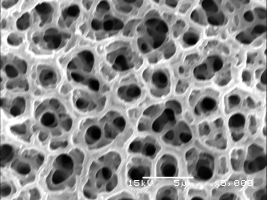Porosity and surface area are important characteristics of solid materials that highly determine the properties and performance of catalysts, sorbents, medicines, pigments, rocks, and so on. “How active is your catalyst” and “How efficient will medicines work” are questions related to features as the presence of pores, porosity, pore size and surface area and can be dealt with by different types of porosity measurements.
Porosity analysis by physical gas adsorption (physisorption), chemical gas adsorption (chemisorption) and mercury intrusion porosimetry is used to characterize pores and surface area related parameters. While gas adsorption is merely used to analyse smaller pores, mercury porosimetry is particularly applicable to porous materials exhibiting larger pores. Our laboratory can measure specific surface areas (BET surface area or related methodologies), pore volume, pore size distributions in the micro-, meso- and macropore range (0.5 nm – 800 µm), density, active metal surface area and metal dispersion of various materials using many dedicated instruments and experimental conditions for each application.
Disclaimer: The results of analysis techniques describing porosity and porous properties are obtained via idealized models and are therefore not necessarily representing geometrical values




